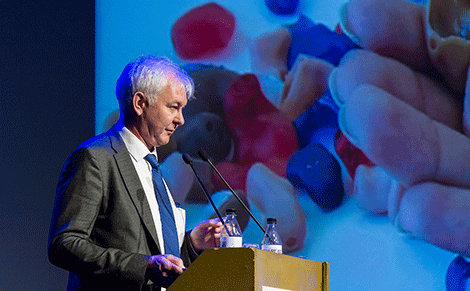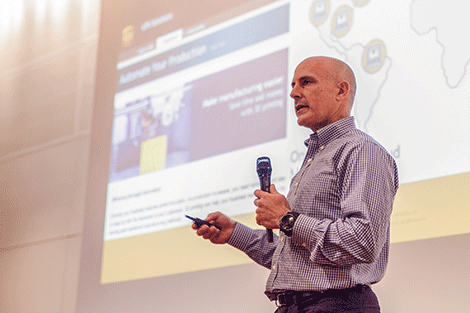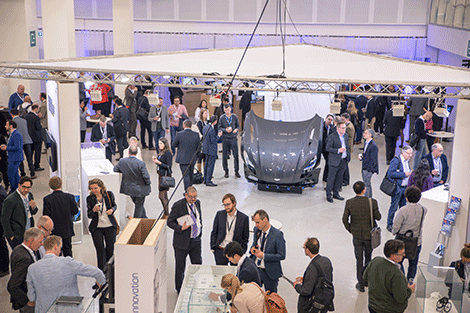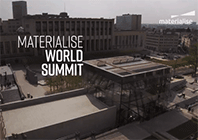
Materialise CEO Wilfried Vancraen closing Materialise World Summit, the 3D printing company’s forum for advancing additive manufacturing technology
Ending Materialise World Summit (MWS), the quiet final words on stage of Materialise CEO Wilfried Vancraen, concluded: “We’re not looking to be one of the central players in 3D printing, but the glue that holds it all together.”
The old Flemish master of 3D printing has it all under one roof – software, hardware and decades of experience – and its biannual global user event was two days encapsulating everything.
Over two days in the Belgian capital, speakers dwelled on problems as specific as replacement parts for aging German steam locomotives, to the gradual evolution of the global supply chain. Blowing hot air or not, the product lifecycle is truly changing, and the digital attributes of 3D printing are key to its production goals.
The path of the digital transformation of companies has been a daunting road, potentially littered with unfavourable consequences. We left MWS realising that Materialise has been at the heart of this journey, holding the hands of a list of major brands and OEMs as they stepped boldy across the brave new frontier.
Sunglasses manufacturer Safilo is clearly a brand not fazed by technology advancements – having been around long enough to shield Elvis Pressley’s eyes from the glare of cheeseburgers, and Elton John’s from the deviances of ‘70s New York – and now 3D printing offers the company a means of rapid prototyping in time for catwalk shows and more.
And, with the guidance of Materialise and designs of serial 3D printed fashion designer Francis Bitonti, Safilo has now moved to combine printed parts with existing metal frames.
These ‘wearable sculptures’ are the latest evolution for a company producing over 1,000 new models for super brands such as Dior and Givenchy each year, some of which are now looking to develop products that are not only crafted to a specific heritage, but immediately customisable.
Customisation of products can strike fear into brands – just how much customisation do you allow regular Joe Public?
The answer seems to lie in how much of this can be incorporated as brand experience – how much can a company drill into its marketing message and sales staff, and how much value can be added to a product from the technology and distribution aspect?
While class-A surfaces might be off limit, things such as custom insoles for running shoes, combined with a localised production and light assembly might be enough to actually improve brand affiliation and distribution.
Distribution, and the introduction of big names like UPS acknowledging the 3D printing sector, has a huge power: transforming existing depots and warehouse spaces from redundant land potentially outmoded by an Uber-isation of delivery methods, and into bases for localised production centres, adding value to brands and an encouragement to continue using UPS in a digitised future.

SAP SVP of IoT and Digital Supply Chain, Gil Perez presenting at MWS
The likes of SAP, represented energetically at MWS by Gil Perez, its SVP of IoT and Digital Supply Chain, are already putting such plans into place, playing the long game and implementing it through its giant B2B procurement platform Ariba Network.
Its assessment for digitisation exists around Minimum Order of Quantity (MOQ): if your traditional production methods have a MOQ of a thousand parts, but you only sell or use 100 each year, then it views localised or service 3D printing as a suitable alternative to storage and distribution costs.
With bases around the globe, and the expertise to advise the implementation of third-party hardware with its software products anywhere, it’s not hard to see why Materialise would deem itself the glue of a new industry segment looking to revolutionise all levels of the consumer market: from point of sale to delivery to your doorstep.
As forward facing as all this seems, Materialise also solves legacy problems for which reverse engineering is so well suited.

An exhibition area gave a snapshot of all the areas Materialise is present in aiding develop 3D printing technologies and workflows for
Deutsche Bahn’s seemingly long-suffering CEO of vehicle maintenance, Uwe Fresenborg, has transformed his stewardship of the maintenance of trains – varying from the cutting edge, to the steam-driven – in only two years with the use of 3D printed parts and Materialise’s assistance.
Years into our coverage of 3D printing, it is still joy to see companies still stumbling across unanticipated benefits brought by the technology, left joyous that, even after it has sourced the final pair of brackets for an ancient engine online, its requirements for three more could be met through a quick scan and print through Materialise.
More advanced was GE’s use of the technology for aerospace – which it has pretty much pioneered at great cost.
Experimental projects, such as allowing an off-the-expenses-book program to update an aged helicopter engine with masterful suitability for the abilities of additive, have seen GE flourish in its application of additive.
The stats speak for themselves: the resulting A-CT7 engine is 35 per cent 3D printed, has reduced the number of parts from 90 down to 40, and has reduced its weight and emissions.
This in turn has led to a new product development: The Advanced Turbo Prop engine, reducing a typical 85-part engine down to 12 3D printed components, with no castings, and in the process making it 20 per cent more efficient while producing 20 per cent fewer emissions than its direct competitor.
Enterprise 3D printing is only just getting to grips with the industrial ecosystem, and with its huge toolbox of printers, engineers and software developers, Materialise is not only a great aid to such developments but adds alignment for all parties.
It’s a fast moving ship, with companies queuing up to board, and while new technologies splash onto the scene, Materialise seems a reliable star to guide their journey. 
With its toolbox of printers, engineers and software, Materialise is transforming industry
Default






